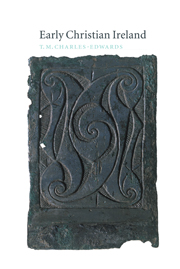Book contents
- Frontmatter
- Contents
- List of maps
- List of tables
- List of figures
- Acknowledgements
- Abbreviations
- A note on pronunciation
- A note on the Chronicle of Ireland
- Introduction
- 1 Ireland in the seventh century: a tour
- 2 Irish society c. 700: I. Communities
- 3 Irish society c. 700: II Social distinctions and moral values
- 4 Ireland and Rome
- 5 Conversion to Christianity
- 6 The organisation of the early Irish Church
- 7 Columba, Iona and Lindisfarne
- 8 Columbanus and his disciples
- 9 The Paschal controversy
- 10 The primatial claims of Armagh, Kildare and Canterbury
- 11 The origins and rise of the Uí Néill
- 12 The kingship of Tara
- 13 The powers of kings
- 14 Conclusion
- Appendix: genealogies and king-lists
- Glossary: Irish and Latin
- Bibliography
- Index
2 - Irish society c. 700: I. Communities
Published online by Cambridge University Press: 11 September 2009
- Frontmatter
- Contents
- List of maps
- List of tables
- List of figures
- Acknowledgements
- Abbreviations
- A note on pronunciation
- A note on the Chronicle of Ireland
- Introduction
- 1 Ireland in the seventh century: a tour
- 2 Irish society c. 700: I. Communities
- 3 Irish society c. 700: II Social distinctions and moral values
- 4 Ireland and Rome
- 5 Conversion to Christianity
- 6 The organisation of the early Irish Church
- 7 Columba, Iona and Lindisfarne
- 8 Columbanus and his disciples
- 9 The Paschal controversy
- 10 The primatial claims of Armagh, Kildare and Canterbury
- 11 The origins and rise of the Uí Néill
- 12 The kingship of Tara
- 13 The powers of kings
- 14 Conclusion
- Appendix: genealogies and king-lists
- Glossary: Irish and Latin
- Bibliography
- Index
Summary
There were three broad categories of layman in Ireland in the seventh and eighth centuries: the aristocrat, the base client and the slave (from now on ‘client’ without qualification will refer to the base client rather than to the more privileged ‘free client’). Between these three there were also intermediate groups, but the three were the principal kinds of person – apart, that is, from people who maintained themselves by skill and knowledge. The latter were sometimes put under a single heading, ‘the people of craft’, áes dána, to distinguish them from ‘the farming people’, áes trebtha. For the moment we are solely concerned with ‘the farming people’.
The deepest divide was between the aristocrat and the client, on the one side, and the slave on the other. The slave class was recruited by birth, judicial penalty and, most importantly, force – as in the great slave raids on western Britain in the fourth and fifth centuries. Slaves from overseas were usually more valuable than natives for they found it more difficult to escape: Patrick had to cross the width of Ireland and secure passage in an Irish ship before he could get to his native island. His venture remained on a knife-edge throughout. Female slaves were valued partly because they could be sexually exploited, partly because escape was, for them, even more difficult than it was for the men. If raiders killed, they were more likely to kill the men but enslave the women.
- Type
- Chapter
- Information
- Early Christian Ireland , pp. 68 - 123Publisher: Cambridge University PressPrint publication year: 2000



